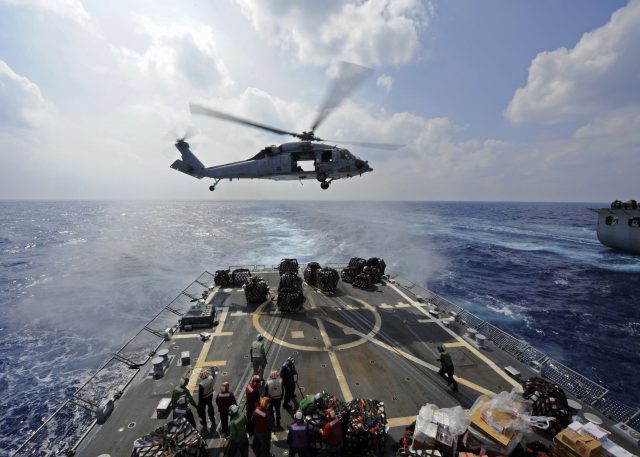
In a recent Strategist post, we discussed the pros and cons of different sized unmanned maritime aerial systems. We came down on the side of larger systems. Geoff Slocombe then took issue with our position, arguing that there’s a lot to be said for smaller systems.
Let’s be clear: Geoff is absolutely right to extol the virtues of small footprint Unmanned Aerial Systems (UAS). At little logistic cost, they can do all sorts of useful things. Unmanned systems have some notable advantages over manned platforms; they’re usually cheaper to operate and have greater endurance (for the same size). In the intelligence, reconnaissance and surveillance (ISR) role they can be the eyes of the ship at distances and in conditions beyond the capabilities of human lookouts. And a future network of small UASs will be able to provide extended and persistent over-the-horizon situational awareness. No task group should be without them. And, if ISR was all you ever wanted to do, there’d be no reason to look much beyond them.
But we don’t spend billions of dollars on surface combatants just to do ISR. There are many cheaper ways to do that these days. We also want our warships to be able to seriously spoil someone else’s day at sea, be it another surface combatant or a submarine. And to terminate someone’s cruise with prejudice from the air, you need an aircraft with a substantial payload.
Operationally, the sensors and weapons on an unmanned system aren’t necessarily different to those on manned systems. That’s because the sensor or weapon has to be fit for its intended purpose, not scaled to accommodate the size of the host platform. In fact, the inverse is true: the size of the platform should be determined based on the sensor or weapons capabilities it’s intended to carry.
Naval helicopters aren’t big solely because of the human crewing aspect—they also need to carry some heavy duty equipment. An MH-60R Seahawk weighs about 7,000kg when empty, and carries an additional 3,000kg of equipment, fuel and crew (4 persons) in its ASW configuration. A typical load-out might include up to three Mk54 ‘lightweight’ torpedos, each of which weighs 275kg. The Seahawk’s AQS-22 dipping sonar weighs a further 272kg, and features a launcher for 25 sonobuoys.
A minimum useful payload for an ASW helicopter is probably about 600kg: at least one torpedo, and either a dipping sonar or a sonobuoy launcher. Ideally it would have the capacity to lift more than 1,500kg of payload: two torpedoes, and both dipping sonar and sonobuoys. There’s a reason that naval combat helicopters are the size they are. You can work a fleet mix in various ways—such as using the Romeo version of the Seahawk to do the sonar work to detect submarines and having another platform providing the high explosive on target (the USN is experimenting with using the utility Sierra model Seahawk as a torpedo truck). But ultimately, you still have to have the grunt to get all the stuff into the right spot.
Another manned ASW helicopter, the AW159 Wildcat, is in service with the UK Royal Navy and Republic of Korea Navy. It’s relatively light at 3,300kg empty, but it can carry more than 2,500kg in payload, fuel and crew. In ASW configuration, the Wildcat carries two crewmembers, two Stingray lightweight torpedos, depth charges, and a dipping sonar system.
By comparison, when we turn to the UAS side, the larger rotary wing ‘Charlie’ version of the US Navy’s MQ-8 Fire Scout is about 1,500kg empty and 2,700kg fully loaded. Almost all of the difference is additional internal fuel—only about 300kg is available to external payloads. It’s a huge advantage for unmanned aircraft that the volume normally occupied by crewmembers and supporting systems can instead be filled with fuel tanks and other equipment, improving the endurance of the platform. But the size of the platform (or, more accurately, the lift available) still limits the useable payload of the vehicle. A Fire Scout payload for an ASW mission would probably be limited to either a small sonobuoy dispenser, or a dipping sonar system. In either case, a Fire Scout probably wouldn’t be able to carry a torpedo as well.
But there’s no law of nature that says a future UAS couldn’t fill the roles of manned ASW helicopters like the Romeo or the Wildcat. In fact, there are big advantages to replacing the crew with an at least partly autonomous control system. And that technology is almost inevitable—we think that too many people thinking about future capability don’t give enough credit to the implications of Moore’s Law. The surface combatant of the future will likely have a mix of small and large embarked aircraft—but it’s a fair bet that they’ll all be unmanned.

